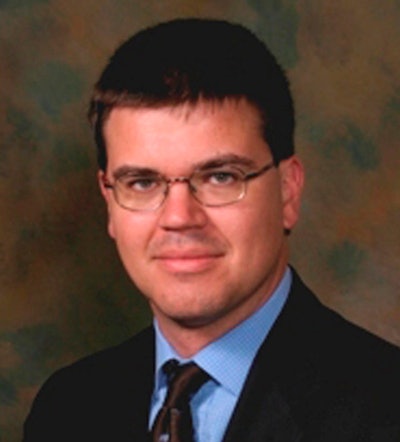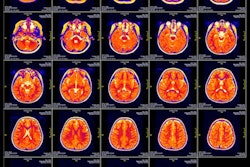
In the early days of the COVID-19 pandemic, CT garnered most of the attention as a tool for early detection of the disease. But as the pandemic wore on and we learned more about the complex effects of this disease, MRI came into its own.
Rather than just an acute condition that primarily affects the lungs, COVID-19 appears to have wide-ranging effects on multiple organ systems that can be experienced over a period of months. For example, one-third of patients hospitalized with COVID-19 experience encephalopathy, which could have long-term implications. Other conditions that can occur include thromboembolism, myocarditis, and various neurological issues.
 Dr. Mahmud Mossa-Basha.
Dr. Mahmud Mossa-Basha.MRI can help clinicians visualize and understand these conditions, thanks to its excellent soft-tissue visualization. At RSNA 2020, MRI's value in coping with the pandemic will be a hot topic, with abstracts particularly focused on the modality's ability to diagnose and track the illness's neurological manifestations.
Additionally, look for research that explores using MRI to assess long-term sequelae and patient outcomes after COVID-19 recovery, according to Dr. Mahmud Mossa-Basha, vice chair for clinical operations and chief of radiology at the University of Washington Medical Center and director of MRI at the University of Washington School of Medicine.
Mossa-Basha is part of the RSNA's COVID-19 task force, which released best practice guidelines in May for keeping radiology running during COVID-19; in April, he and a team from the university published a paper outlining strategies for handling the pandemic culled from their experience in Seattle.
"Expect discussion on the need for modified MRI workflows in a pandemic, as well as increased MRI efficiencies to facilitate equipment cleaning and to address MRI backlogs," he told AuntMinnie.com.
AI for MRI
All across radiology, artificial intelligence (AI) is making an impact, and MRI is no exception, according to RSNA 2020's neuroradiology subcommittee head, Dr. Max Wintermark of Stanford University. At the meeting, look for abstracts that address the use of AI with MRI, with a focus on moving beyond diagnosis of disease and into treatment, Wintermark said.
 Dr. Max Wintermark.
Dr. Max Wintermark."It's long been true that we can diagnose patients with neurological conditions using MRI, but not necessarily use the modality to treat them," he said. "But we're seeing more research that describes MRI-guided procedures that either help clinicians identify good candidates for particular treatments or help them administer the treatment. A good example of this is using MRI or PET/MRI to diagnose and treat Alzheimer's disease."
Radiologists are looking to AI to make workflow more efficient, especially since the U.S. Centers for Medicare and Medicaid Services continues to cut reimbursement levels -- and MRI tends to be a high-cost exam. But sometimes focusing too much on efficiency can backfire, according to Mossa-Basha.
"Politicians may not understand the value of imaging," he said. "They know it's important for diagnosis, but when they look at expense reports, they see that imaging is a big contributor, so they decide to cut payments. Then radiologists try to scan faster and read more to maintain volume, which then continues the cycle of higher costs in the eyes of the policymakers."
The use of artificial intelligence algorithms for MR image reconstruction will be among the main areas of discussion at RSNA 2020, said Jerome Liang, PhD, RSNA physics subcommittee chair and a professor at Stony Brook University Hospital in Stony Brook, NY.
"AI has most relevance in MRI because of the type of data that can be had," Liang told AuntMinnie.com. "We're starting to see that AI can do a good job for image reconstruction in MRI."
Colombini anniversary and MRI safety
Also coming in 2021 is the 20th anniversary of the death of Michael Columbini, a 6-year-old child who was struck by an oxygen cannister while he was in the scanner. Columbini's death was a huge wake-up call, according to Tobias Gilk, senior vice president of Radiology-Planning, founder of Gilk Radiology Consultants, and an MRI safety advocate.
 Tobias Gilk.
Tobias Gilk."Michael Columbini's death highlighted that we don't just need to address clinical practice changes as MRI technology improves, but also we need to look carefully at MRI operations, safety, and staff training," he said. "And still, 20 years later, this hasn't been done in any kind of 'big picture' way. We need to reflect on the scope and magnitude of MRI technology changes and determine how to handle them in daily clinical practice."
This year, the American College of Radiology (ACR) came out with new MRI safety guidelines; these included an updated personnel requirement that mandates at least two staff members in the MRI suite during the exam.
There's been some pushback on this guidance, Gilk noted.
"This 'plus one' staffing requirement for accreditation generated a lot of response, with physicians saying they don't have money or time to comply," he said. "And now with COVID-19, it may be even harder to enforce this."
Also at RSNA 2020, expect MRI discussions on safety standardization that include input from the American Board of Magnetic Resonance Safety. In addition, a session facilitated by Dr. Emanuel Kanal, director of MR services at the University of Pittsburgh, will use the MagnetVision app he developed to teach attendees how to assess risk in patients with metal implants, devices, or foreign bodies.
Dr. Emanuel Kanal of the University of Pittsburgh talks about his MagnetVision app in a video from RSNA 2017.
MRI for kids
There are exciting trends in pediatric radiology with MRI, from using the modality to map the neonatal brain to imaging the lungs, according to RSNA pediatric radiology subcommittee chair Dr. Lynn Fordham of the University of North Carolina at Chapel Hill.
 Dr. Lynn Fordham.
Dr. Lynn Fordham."We are seeing people really pushing the boundaries in pediatric MRI, moving from anatomical imaging to much more functional imaging," she told AuntMinnie.com.
Fordham also sees a trend toward more rapid acquisition techniques and higher magnet strengths, which will help clinicians get better quality images faster.
"These improvements will allow us to decrease sedation," she said. "Even if our patients are in the scanner for the same amount of time, we'll be able to image their whole body instead of just the abdomen."
Novel techniques
Several techniques are on the horizon for continued exploration and development in MRI, according to Mossa-Basha:
- Wave-CAIPI (controlled aliasing in parallel imaging)
- Compressed sensing reconstruction processes
- Time-spatial labeling inversion pulse (Time-SLIP) MR imaging for visualizing cerebrospinal fluid flow dynamics
- Using other molecules in MR imaging, such as sodium
This last one especially shows promise, he told AuntMinnie.com.
"Tracking other molecules gives us the opportunity to look at disease in a different way," he said. "For instance, sodium imaging of stroke or the prostate shows different aspects of pathology than conventional MR imaging does."
In emergency radiology, MRI research at RSNA 2020 will focus on topics like finding fractures and evaluating the abdomen in the younger population and pregnant women, said Dr. Ferco Berger, RSNA emergency radiology subcommittee chair and head of emergency and trauma radiology at Sunnybrook Health Sciences Centre in Toronto.
"The work that is being done [in emergency radiology] is focusing on getting the protocols to be shorter, because MRI takes more time to do, which is not always a good thing in the emergency setting with patients in discomfort," Berger said.
Tech is driving new applications
 Dr. Emanuel Kanal.
Dr. Emanuel Kanal.Need tends to drive new technology, but new technology also creates opportunities to use MRI for more applications, Gilk said. It's kind of a "chicken-and-egg" situation: Changes in clinical applications push changes in MR hardware, which then facilitates more applications.
"There's an important relationship between changes in clinical practice and then what that demands from MRI hardware," he said. "Historically, MRI was used for generally ambulatory patients. Now we're seeing it being used to image stroke and in postsurgical, [intensive-care-unit], and ventilator patients. The breadth of patients, the acuity and type of disease, and the complexity of clinical questions we're using MRI to address has dramatically increased over the past decade."
The modality has seen two new examples of this in recent years. Aspect Imaging's Embrace Neonatal MRI is a 1-tesla unit that debuted in 2017 and does not require a special safety zone or a radiofrequency-shielded room. With Embrace, newborns can undergo brain scans without being moved from the neonatal intensive care unit using a special incubator that goes into the tube.
The other new technology that hit the MRI scene this year was Hyperfine's Swoop portable MRI unit, which can be used at bedside. The device received clearance from the U.S. Food and Drug Administration in August. It plugs into a standard electrical wall outlet and is controlled through a wireless tablet.
"Both of these devices are prompting us to rethink what an MRI machine looks like and where it lives," Gilk said. "New technology like this will allow us to use MRI in clinical situations where it has previously been impossible or impractical."
Programming schedule
Look for these MRI-related sessions at the virtual RSNA 2020.
Sunday, November 29
- 8:30 a.m.-9:30 a.m. -- Science Session with Keynote: Neuroradiology (Brain-Stroke Imaging 1)
- 10:00 a.m.-11:00 a.m. -- Science Session: Breast Imaging (MRI)
- 5:00 p.m.- 6:00 p.m. -- Liver MRI Essentials
Monday, November 30
- 8:30 a.m.-9:30 a.m. -- Education Session: Essentials of Neuro Imaging
- 10:00 a.m.-11:00 a.m. -- Hot Topic Session: Neurological and Neuroimaging Manifestations of COVID-19
- 2:00 p.m.-3:00 p.m. -- Science Session with Keynote: Neuroradiology (Brain Tumor Imaging)
Tuesday, December 1
- 8:30 a.m.-9:30 a.m. -- Education Session: Molecular Neuroimaging
- 5:00 p.m.-6:00 p.m. -- Hot Topic Session: Nonpulmonary Manifestation of COVID-19
Wednesday, December 2
- 2:00 p.m.-3:00 p.m. -- Education Session: Practical Aspects of MR
- 3:30 p.m.-4:30 p.m. -- Science Session: Breast Imaging (MRI)
- 5:00 p.m.-6:00 p.m. -- Education Session: Neuroradiology/Head and Neck (Head and Neck Tumor Imaging)
Thursday, December 3
- 8:30 a.m.-9:30 a.m. -- Education Session: MRI 0-RADS
- 8:30 a.m.-9:30 a.m. -- Science Session: Neuroradiology (Neuro Spine Imaging)
- 10:00 a.m.-11:00 a.m. -- Education Session: Peripheral Artery Disease: CTA and MRA
- 5:00 p.m.-6:00 p.m. -- Education Session: Status of the ABR Maintenance of Certification (MOC) Program for Medical Physicists
Friday, December 4
- 3:30 p.m.-4:30 p.m. -- Hot Topic Session: Integration of Novel Blood, CSF and Imaging Biomarkers for the Early Diagnosis of Alzheimer's Disease
- 5:00 p.m.-6:00 p.m. -- Education Session: Case-based Review of Magnetic Resonance
Saturday, December 5
- 2:00 p.m.-3:30 p.m. -- Science Session with Keynote: Neuroradiology/Head and Neck (Neuro AI: Image Interpretation)
- 3:30 p.m.-4:30 p.m. -- Hot Topic Session: Stroke Imaging -- How Recent Trials Are Changing Radiologists' Practices
All events are listed in Central time.



.fFmgij6Hin.png?auto=compress%2Cformat&fit=crop&h=100&q=70&w=100)





.fFmgij6Hin.png?auto=compress%2Cformat&fit=crop&h=167&q=70&w=250)











